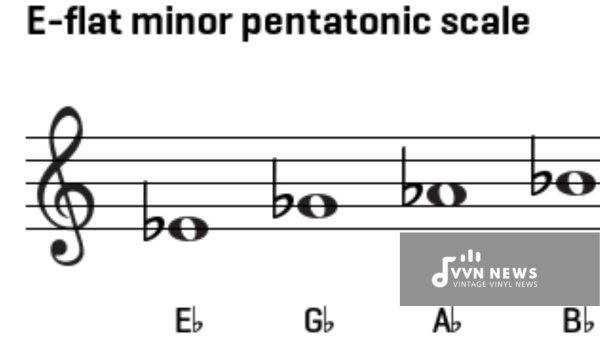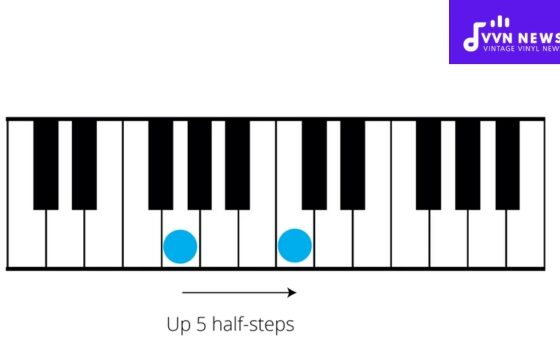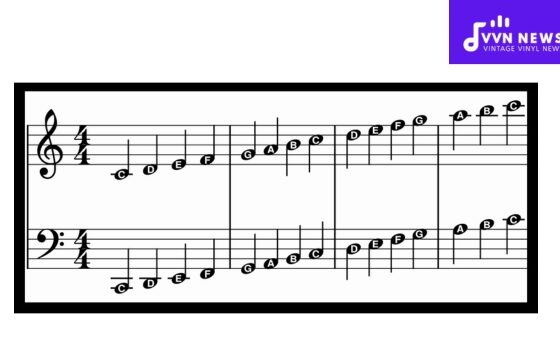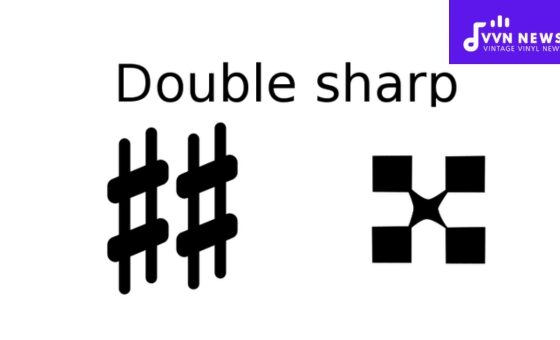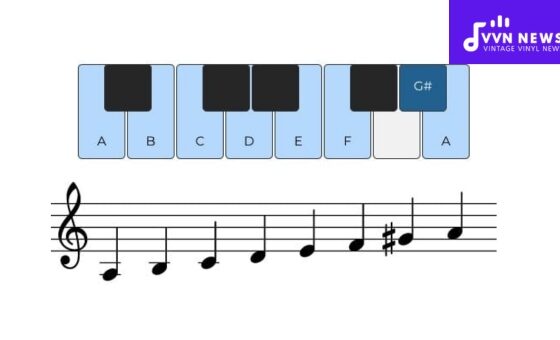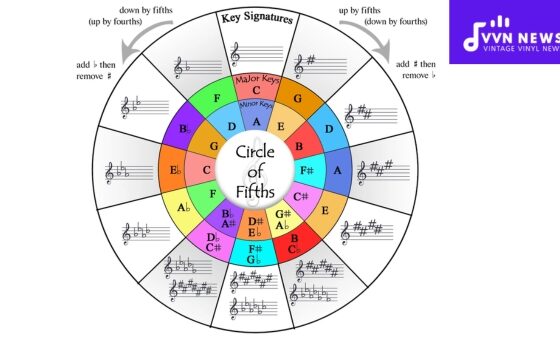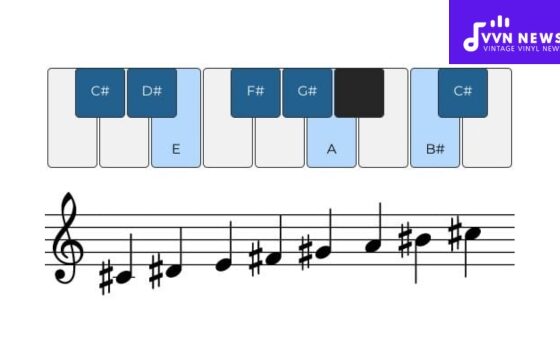If you’ve journeyed into the world of music, there’s a good chance you’ve heard or even played the E flat minor pentatonic scale.
This might sound like a complex term, but it’s merely a specific sequence of notes that often create the melodic foundation for many of our favorite songs.
Playing the E flat minor pentatonic scale not only develops your musical ear but also helps to improve your finger agility and technical know-how on whatever instrument you choose to play.
It has an exotic, almost mystical sound to it, which lends itself beautifully to various genres, from jazz and blues to rock and pop.
Surprisingly simple yet hugely versatile, the E flat minor pentatonic scale is a valuable tool for any musician’s toolkit.
What is the E Flat Minor Pentatonic Scale?
The E flat minor pentatonic scale, a staple in the world of music creation, is a five-note sequence within the minor scale.
So as its name suggests, it’s composed of five unique notes: E flat (Eb), G flat (Gb), A flat (Ab), Bb, and Db.
The ‘E flat’ in its name signifies that it starts on this note – a detail paramount to creating the desired sound and tone from this scale.
Rooted in simplicity and rich with expressive potential, this popular scale sets the stage for exploring an array of melodies on your instrument of choice.
How do you build the E Flat Minor Pentatonic Scale?

The construction of the E flat minor pentatonic scale is relatively straightforward.
Essentially, it comprises five notes, which, in the case of E flat minor, are E♭, G♭, A♭, B♭, and D♭.
Framework for building your scale
There is a fundamental framework for creating your pentatonic scale:
- The root note: This is your starting point – in this case, E♭.
- Minor third: Count three semitones higher (or keys to the right on a piano) to find your second note – G♭.
- Perfect fourth: Add another two semitones to see your third note – A♭.
- Perfect fifth: Two semitones higher takes us to our fourth note – B♭.
- Minor seventh: Skip three semitones, and here you land on D♭.
To complete the octave and form a full circular sequence close at E flat again, jump just two semitones from D flat.
The above framework lets you build not only the E flat minor pentatonic scale but any minor pentatonic scale.
By changing only your root note—your starting point—you can create a whole array of scales.
This versatility represents one of the striking features that render pentatonic scales so integral to music theory.
Also Read: E Flat Major Triad [Music Theory Explained In Easy Steps]
Describing the Various Positions of the E Flat Minor Pentatonic Scale
In essence, knowing the different positions or shapes of the E Flat Minor Pentatonic scale can enhance your musical versatility.
It holds no matter if you are a guitarist, pianist, or even a violinist. The use of these different positions translates into your ability to invent solos or create melodies across your instrument’s neck.
There are five primary shapes you’ll need to master. Remember, the positioning will depend on your instrument and where the E flat (Eb) is found on it.
Root Note on the Low E String
To start with, this position demands that your root note be situated on the lower E string.
Generally, this shape is nothing short of an essential starting point for guitarists willing to venture into playing pentatonic scales.
Position Shift
This second position entails a shift up to an octave higher with root notes situated on either A string.
The crux of effectively playing this shape is an ability to oversee precision in moving between frets.
Emphasis on B String
Shifting one more time, we move into our third shape or position for the Eb minor pentatonic scale where the focus rests heavily upon the B string for root notes.
Back to Low E String
As we approach our penultimate shape, movements revert towards the lower E string; yet again as a prime source for root notes amidst every other subsequent note of this particular pentatonic scale structure.
Last Octave Shift
In our fifth and final shape assume yet another octave shift; emphasis being drawn towards high E strings while trying to reign in precision and fluency within fingerwork.
Each of these positions presents their unique diapasons or range of pitches opening up new doors for musical exploration.
By acquiring the knack to shift between these positions, you can create a dynamic and rich solo on your instrument.
The Major and Minor Scales of the E Flat Minor Pentatonic Scale
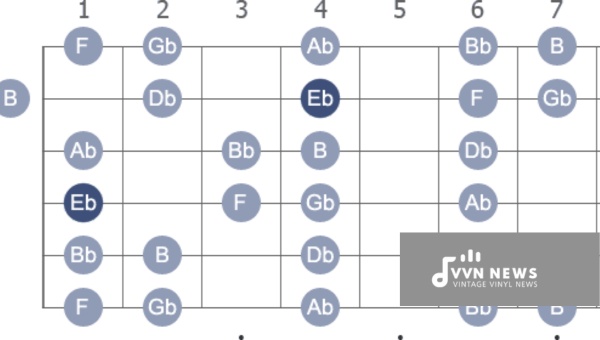
A categorical distinction within musical scales lies between major scales and minor scales.
These are foundational elements in music theory that differentiate cheerful-sounding music, typically associated with major scales, from the melancholic feel of minor scales.
Major Scales
Let’s focus our attention, first, on major scales. Considered joyful and buoyant in tone, they form the backbone of a vast range of melodies we know and love.
A major pentatonic scale includes five notes per octave as opposed to the seven we find in a full diatonic major scale.
Here is an example of a C Major Pentatonic Scale: C – D – E – G – A
In this case, you may notice that we have eliminated the fourth and seventh notes of a complete C Major scale.
Minor Scales
We now shift our focus to minor scales. Echoing with a more somber or contemplative tonality, they can add depth and nuance to any composition.
Specifically, when creating an E Flat Minor Pentatonic Scale, you would follow this pattern:
E♭ – B♭ – D♭ – E♭
For aspiring musicians aiming to master both realms of this transformative scale performance technique, these distinctions between the major and minor variants are invaluable.
Also Read: F Sharp Major Chords [Boost Your Guitar Skills Today]
Tips for practicing the E Flat Minor Pentatonic Scale with music tracks?
Forming a connection with the E flat minor pentatonic scale doesn’t have to be puzzling or trying.
Here are some strategies to help you improve your performance:
Pick your favorite track
Select any music track that you are fond of, which is composed in E flat minor pentatonic.
This approach adds an element of fun, making your practice session feel less like work and more like play.
Implement the scale step-by-step
Start by finding the position on your instrument that corresponds to the E flat note. From there, take small strides.
Play minimally at first then build up, progressively adding more notes until you complete the whole scale. You want to become accustomed to each note and the variations thereof.
Utilize available online resources
Online platforms such as YouTube host a bounty of backing tracks specifically designed for individual practice sessions.
Seeking out tracks specifically intended for practicing E flat minor pentatonic will impressively enhance your proficiency.
Listen keenly
Your ears will be vital in this exercise since they’ll ascertain if you are playing the right notes correctly or not.
As you listen to yourself play along with tracks, pay attention exceptionally to areas where discrepancies might occur.
Slow and Steady
The old saying “Slow and steady win the race” holds very true here. Even though it might be tempting to play at the same pace as your favorite track right off the bat, it’s important to take your time.
Start slow, gain confidence, and gradually boost your speed.
Success is built on a solid foundation of practice. While these guidelines can direct you on your journey with the E flat minor pentatonic scale, discovering the ease and familiarity of navigating this musical wonder lies in consistent effort.
Importance of Ear Training in Grasping the E Flat Minor Pentatonic Scale
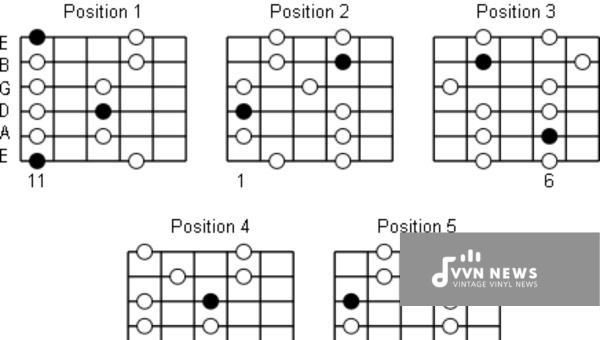
Acquiring skills in ear training is a crucial aspect of grasping melodies, scales, and chords, including the E Flat Minor Pentatonic Scale.
This auditory refinement expresses itself in numerous benefits when playing this distinct scale.
Recognizing Intervals and Notes
Critical to any musician’s journey is the ability to recognize intervals and notes, commonly referred to as musical hearing.
When you sharpen your listening abilities, you’re more likely to discern the leaps or steps between notes in the E flat minor pentatonic scale.
For instance, you could identify a small leap (minor second) from E flat (root note) up to F flat (flat second).
Simultaneously, ear training lets you identify larger intervals quickly such as the minor seventh from E flat to D flat in this pentatonic sequence.
Calibration of Pitch Detection
In addition, superior pitch detection is another feather in your musical cap that ear training can bring.
Differentiating between multiple pitches played simultaneously becomes simpler.
For instance, recognizing an E flat note amidst a cluster of other tones helps learn this unique pentatonic scale.
Creation of Musical Cohesion
Further, ear training facilitates musical cohesion. You’ll start synchronizing better with other musicians by accurately picking up rhythm changes or melodic shifts on the fly during your jam sessions.
This strengthens your performance of pieces featuring the E Flat minor pentatonic scale.
Replication and Improvisation
Ear training enhances knowledge application in music replication or improvisation.
A well-trained ear allows for effortless reproduction of songs with heavy use of this scale but also promotes innovative interpretations that breathe personal flair into your music.
Investing time into regular ear training exercises can thus reap multifaceted rewards for anyone keen on mastering this melodious minor masterpiece- The E Flat Minor Pentatonic Scale.
Also Read: E Minor Chords [Complete Guide With Tips & Tricks]
What famous songs feature the E Flat Minor Pentatonic Scale?
This wonderous scale has been an integral part of countless successful compositions.
Certain songs highlight the beauty and versatility of the E Flat Minor Pentatonic Scale, making it more familiar to our ears than we might realize.
Let’s delve into some tracks showcasing this enchanting harmony. The objective is to appreciate how these notes come together to create memorable melodies.
“Hey Joe” by Jimi Hendrix
A flat minor pentatonic scale surfaces beautifully in Jimi Hendrix’s cover of “Hey Joe.”
Hendrix’s guitar work here involves a distinctive flavor of bluesy rock, demonstrating how this scale can adapt to various styles.
“Stairway to Heaven” by Led Zeppelin
Don’t get fooled by the song’s tranquil opening. The guitar solo section near the end rings with notes from the E flat minor pentatonic scale that mesmerize the listener utterly.
It’s a testament to how this humble scale can contribute to massive hits in music history.
“Black Magic Woman,” as performed by Santana
Even genres like Latin-flavored rock borrow heavily from our beloved scale, as seen with Santana’s iconic rendition of “Black Magic Woman.”
This track showcases an improvisational solo revolving around E flat minor pentatonic.
The beauty of these compositions lies not just in their memorable melodies but also in their seamless incorporation of E Flat Minor Pentatonic Scale.
Regardless of musical genre or era, this versatile series of notes can unify a composition into something truly outstanding.
By listening to these songs actively, isolating each note’s sound and sensation, we can further admire the role they play individually and alongside each other.
Music being an auditory art form, it requires active engagement on multiple levels: physical (tapping toes or moving body), cognitive (concentrating on patterns and tonal shifts), emotional (feeling pleasure or discomfort), and spiritual (feeling connected to a bigger universe beyond one’s small world).
FAQs About The E Flat Minor Pentatonic Scale
What’s the makeup of an E Flat Minor Pentatonic scale?
An E Flat Minor Pentatonic scale has five notes: Eb, Gb, Ab, Bb, and Db.
How does the E Flat Minor Pentatonic scale fit into different music genres?
This versatile scale fits well into various genres from blues and jazz to rock and pop, giving a soulful and moody feeling.
Why should I learn the E Flat Minor Pentatonic scale?
Learning the E Flat Minor Pentatonic Scale helps improve your musical ear, and technical instrumental skills and enhances your understanding of melodies in many songs.
What’s a good practice routine for the E Flat Minor Pentatonic scale?
Try practicing this scale with backing tracks in different tempos or use it as a basis for improvisation.
How does ear training relate to the E flat minor pentatonic scale?
Ear training helps you recognize these scales by improving sensitivity to their unique sound structures.
Conclusion
The E Flat Minor Pentatonic Scale can be a daunting concept to grasp, particularly for those new to the world of music.
However, once you’ve familiarized yourself with the scale’s structure and know how to play its various positions, you’ll realize it’s a simple yet powerful tool.
From blues and jazz to rock and pop, this scale is versatile enough for any genre.
So dive in, practice, and learn songs that use this scale, and before you know it you’ll not only understand it but also truly love the E Flat Minor Pentatonic Scale.
